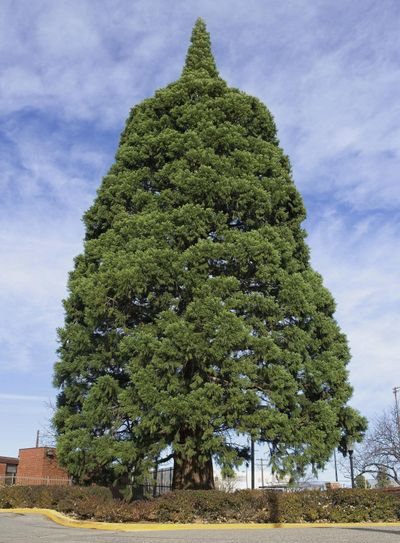Rolling sequoia: Idaho tree tied to John Muir set for move

BOISE – Not very often does a 10-story-tall, 800,000-pound landmark change locations. Especially one that’s alive.
But workers in Idaho will attempt just that starting Friday. A massive sequoia sent to Boise as a small seedling by naturalist John Muir more than a century ago is now in the way of a hospital’s expansion and plans are to move it two blocks away to city property.
“We’ve all got our fingers crossed that the tree is going to make it to its new location,” said Mary Grandjean, the granddaughter of an Idaho forester who received the sequoia seedlings from Muir around 1912.
St. Luke’s Health System is doing more than hoping. It’s spending $300,000 to move the largest sequoia in the state, rather than chopping it down and risking a public relations backlash.
“We understand the importance of this tree to this community,” said Anita Kissie, spokeswoman for the hospital. Cutting it down “was never even an option.”
Even the tree company hired to do the move is feeling the pressure to keep the 98-foot tree upright as it travels about two blocks over about 12 hours to its new home.
“This is going to be one of what we call our champion trees,” said David Cox, who is overseeing the move for Texas-based Environmental Design. “We want to take extreme care to make sure everything goes well.”
Cox said the tree will be the tallest the company has ever moved, as well as the largest in circumference at more than 20 feet near its base. He puts the chances of the tree surviving at 95 percent.
“We’ve got all the equipment we need here,” he said Thursday.
The plan is to lift the sequoia Friday afternoon onto the inflatable, rolling tubes. The tree is set to start moving at midnight Saturday on the rolling tubes and arrive around noon Sunday.
It grew from one of four sequoia seedlings that Muir sent to Emile Grandjean, a conservation-minded professional forester and early employee of the U.S. Forest Service in Idaho, his granddaughter told the Associated Press.
Mary Grandjean’s father told her that Emile Grandjean planted two of the sequoias at his home in Boise and the two others went to the home of Fred and Alice Pittenger, both doctors.
New owners of the Grandjean home later cut down the trees, said Mary Grandjean, noting what a blow it was to her family. The fate of a third sequoia isn’t clear. Of the four trees, the only remaining one is being moved.
“My family and I are very hopeful that the transplanting will be successful,” she said.
Cox said sequoias in their native habitat in California draw moisture from the misty atmosphere and can live for several thousand years and reach several hundred feet tall.
The Idaho sequoia is in a drier, colder climate, and the tree lost its original top in the 1980s due to damage from Christmas decorations that people strung on it. At that point, the hospital hired tree experts and the sequoia has thrived despite living in the high desert.
Soil analysis has been done at the transplant site to ensure it will allow the tree to keep growing, Cox said. Most of the soil surrounding the roots also is moving to improve the tree’s chances, he said.
If it works, it could remain a Boise landmark for several more centuries.
“I would say three- to five-hundred years at least,” Cox said. “It’s still a young tree.”